Gatte Ki Sabji is one of those many dishes, that is a part of the flavorful and versatile Rajasthani cuisine. This recipe is a popular gravy-based dish with gatta (plural: gatte), small gram flour (besan) roundels or dumplings that are added to a spiced curd (yogurt) gravy. There are many variations of making this delicacy from the cuisine of Rajasthan. It may differ from household to household, or even region to region in this beautiful north Indian state.
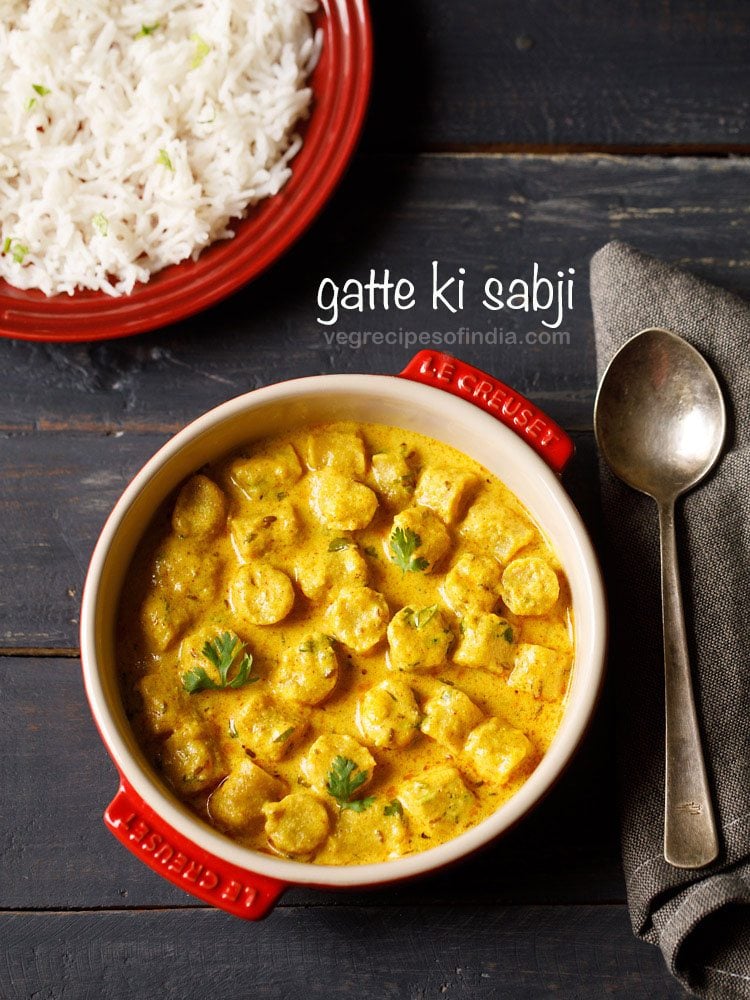
About Gatte Ki Sabji
Given the topography and climatic conditions, that is arid, of the state of Rajasthan, there is obviously a dearth of water and vegetation naturally. This also means that the food culture of this area does not use a lot of fresh vegetables and produce, and/or also rely on a lot of meat-based dishes.
So automatically, the Rajasthani or Marwari style of cooking uses unique plant-based foods from the desert, dried beans, lentils, gram flour or chickpea flour, buttermilk and milk. The spices, especially the red chilies and oil in their food acts as a natural preservative. For instance, this Gatte Ki Sabji is one of the trademark dishes of Rajasthani cuisine.
Table of Contents
Gatte Ki Sabji is simply a tempered curd-based gravy with steamed gatte doused in it. Gatte (singular: gatta) are nothing but small dumplings made of a spiced, semi-soft dough of gram flour or besan. These are dunked in boiling water, cooked, strained and used for the curry.
As the Gatte Ki Sabji doesn’t have any fresh veggies in it, it is also a perfect example of a recipe, fit for dry and water-less climatic conditions like that of Rajasthan. Thus, a preferred choice of food for many, even on a regular every day basis. In addition to this, another well-known specialty for the people in this part of the country is this Rajasthani Kadhi.
In our household, we prepare a Punjabi-style Gatte Ki Sabji using an onion-tomato sauce without including yogurt. As I’ve previously noted, the Rajasthani rendition of this dish requires yogurt. Alongside yogurt, variations of the recipe might include onions and tomatoes.
For this Gatte Ki Sabji preparation, I opted for onions alongside ginger and garlic for enhanced flavor. I aimed for a rich taste in the dish, hence the inclusion of these ingredients. But you can actually skip the onion and garlic. In their absence, the end result would be a dish with a gravy or sauce more like a gatte ki kadhi.
Since I had been getting a lot of requests to post a recipe on the Gatte Ki Sabji, I had to make it. Making gatta is quite straightforward. By following this recipe carefully, you’ll achieve tender gatta that remain soft and light even after cooking.
However, making the entire Gatte Ki Sabji does take some time. The result of your efforts will be a delectable gatta sabzi that pairs equally well with steamed rice or roti, offering a delightful dining experience.
How to make Gatte Ki Sabji
Making dough for gatte
1. In a large bowl or a plate, take 2 cups (200 grams) gram flour (besan).
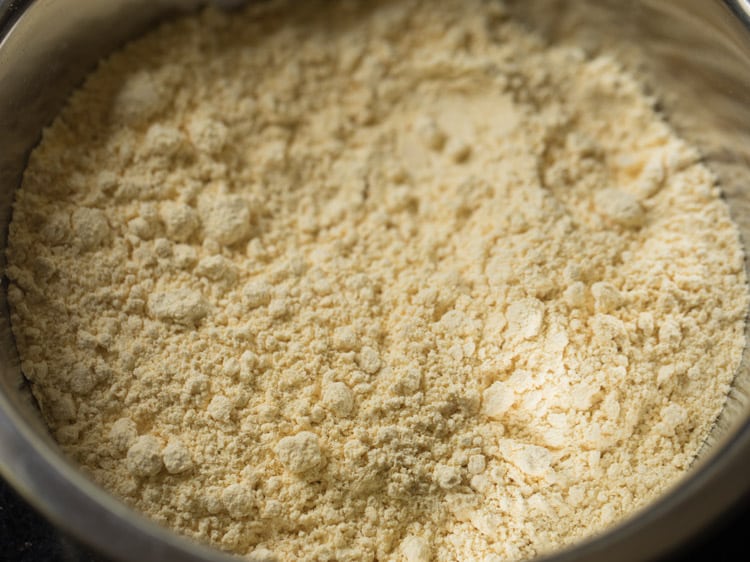
2. Add 1 pinch asafoetida (hing), ¼ teaspoon turmeric powder, ½ teaspoon carom seeds (ajwain), ½ teaspoon red chili powder, 1 teaspoon coriander powder and 1 teaspoon salt or as per taste.
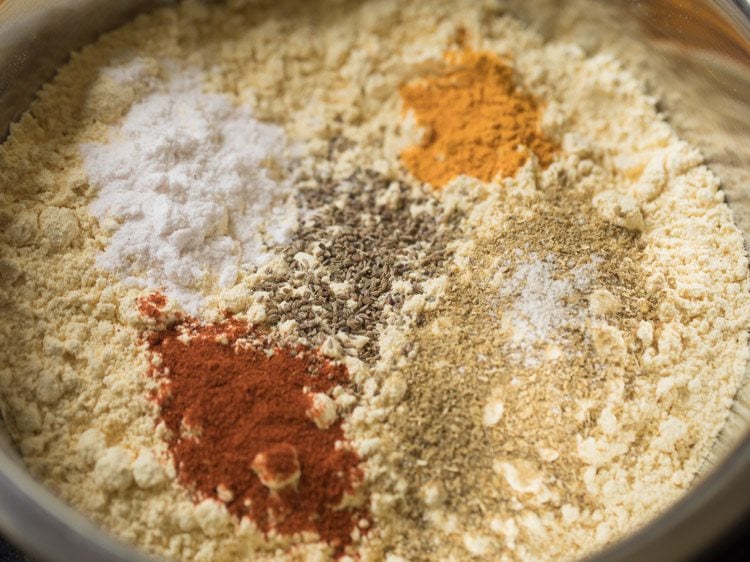
3. Add 3 tablespoons oil and 2 tablespoons curd.
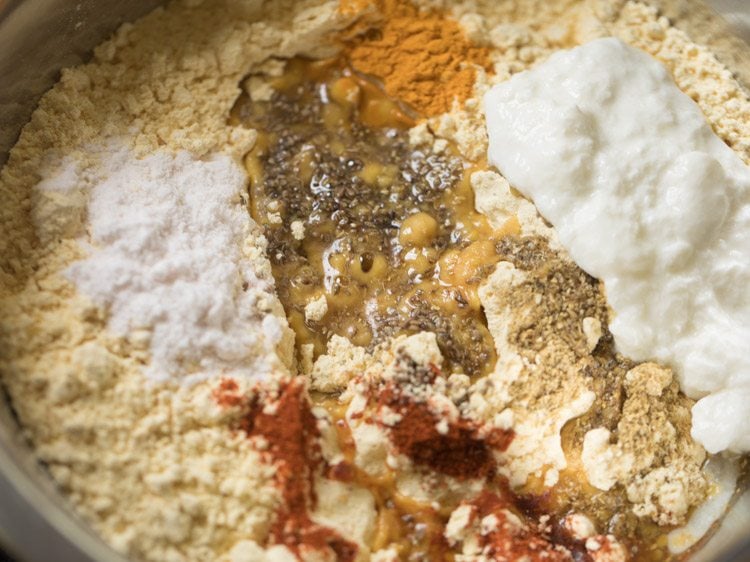
4. Mix everything very well, making sure that the oil is mixed evenly.
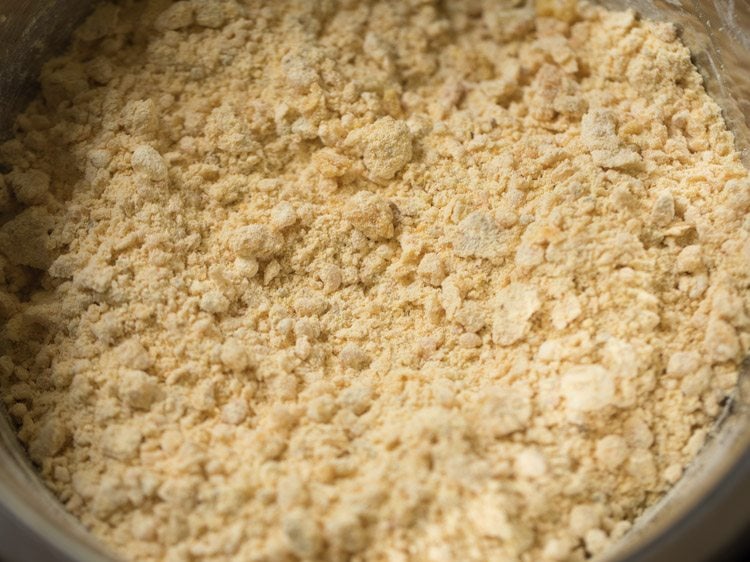
5. Then, add water in parts and begin to knead. Knead very well allowing the besan to absorb water. Overall knead for 10 to 11 minutes.
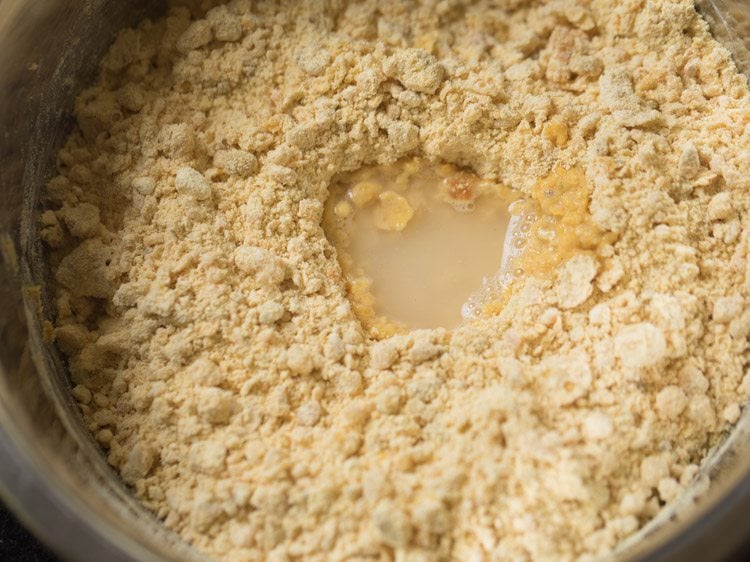
6. You will need 4 to 5 tablespoons water. Addition of water will depend on the type of flour. Also, if the curd used is watery or has more whey in it, less water will be required.
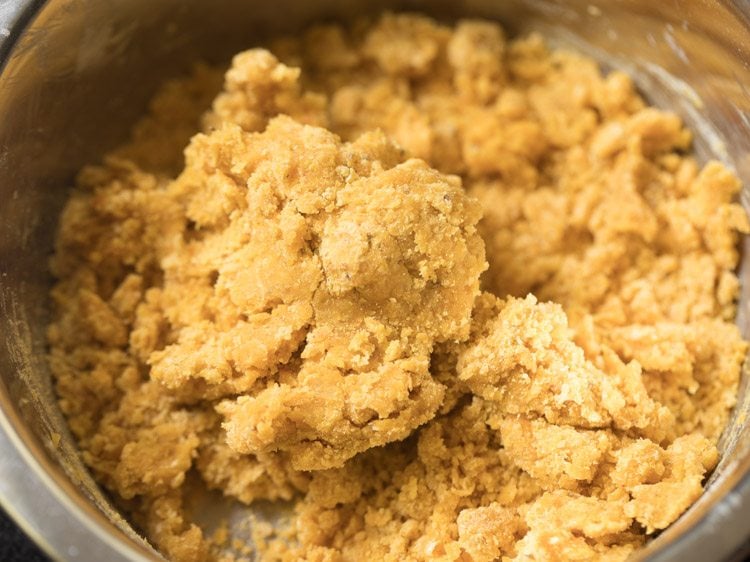
7. Knead to a semi soft dough, like that of a poori. It should be easy to roll and shape without applying too much of force or strength. You should not see cracks on the dough. If there are cracks, then sprinkle water and continue to knead. In case the dough becomes sticky, then sprinkle some besan and knead again.
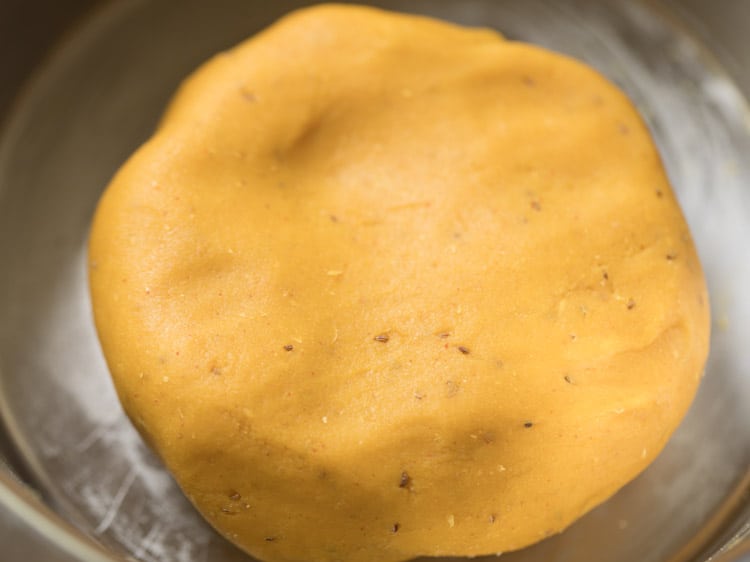
Cooking gatte
8. Before making the gatte, heat 4 cups water in a pan or kadai on medium or medium-high heat.
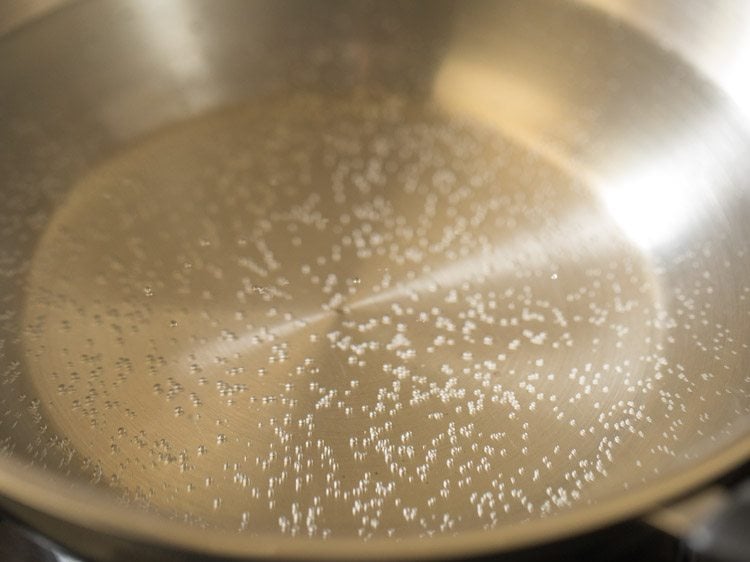
9. Divide the besan dough in 6 equal parts. Roll each part to a smooth ball.
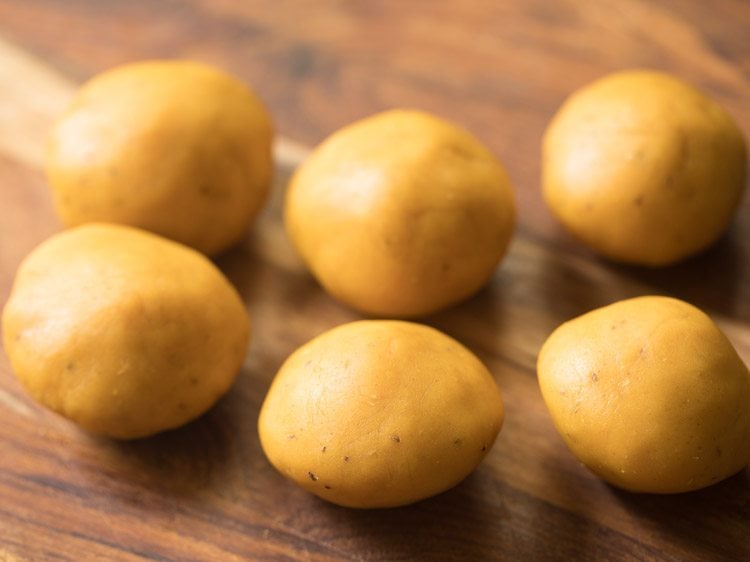
10. Now with your fingers, roll each dough ball to a soup stick like cylindrical shape.
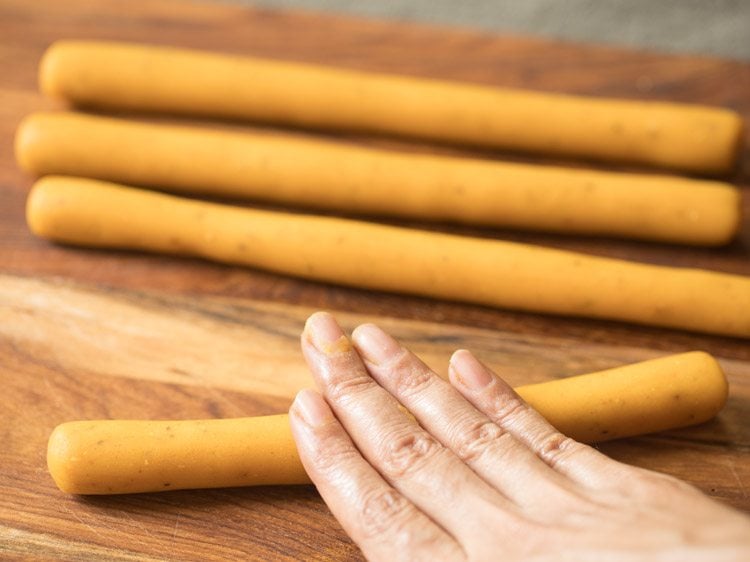
11. Do this with all the 6 dough balls. Slice each dough piece in 2 to 3 parts, so that they can be placed easily in the kadai.
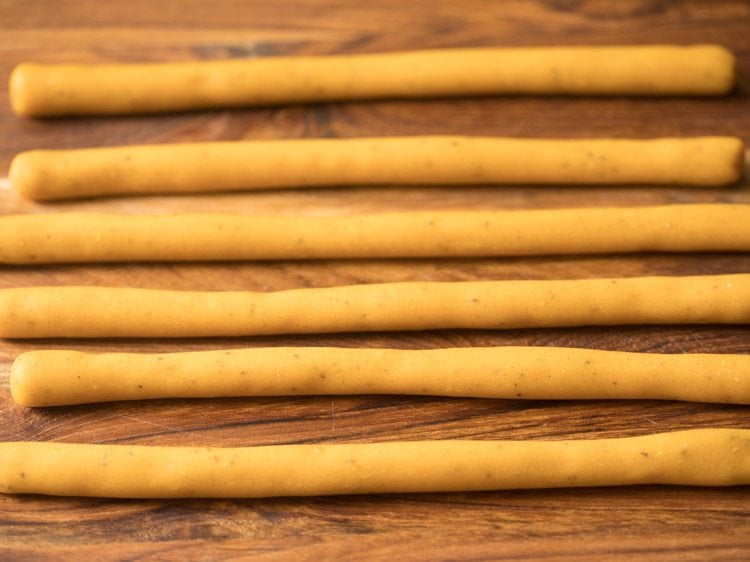
12. Increase the heat to a high or medium-high and let the water come to a boil.
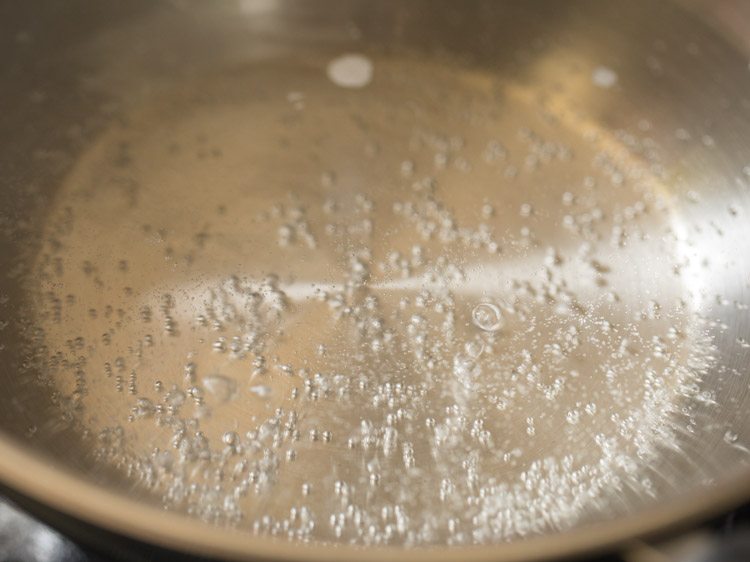
13. Now, gently place gatte pieces in the boiling water.
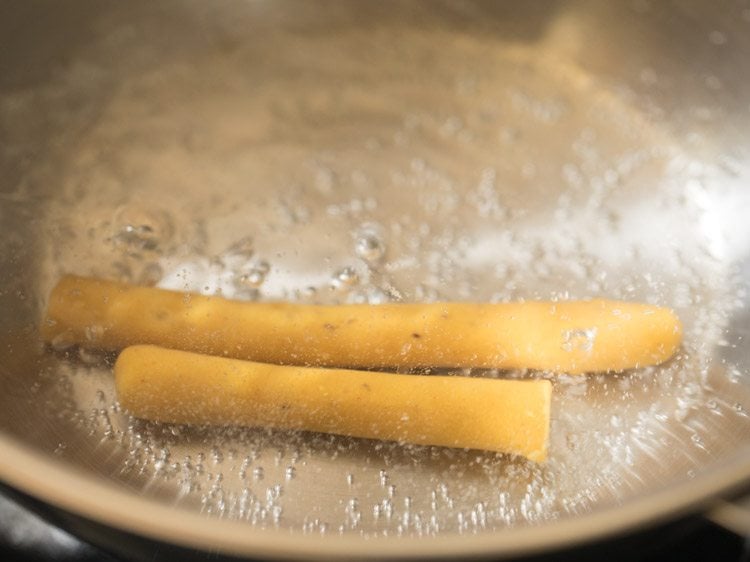
14. Do not over crowd the pan. So, its better to use a medium to large kadai.
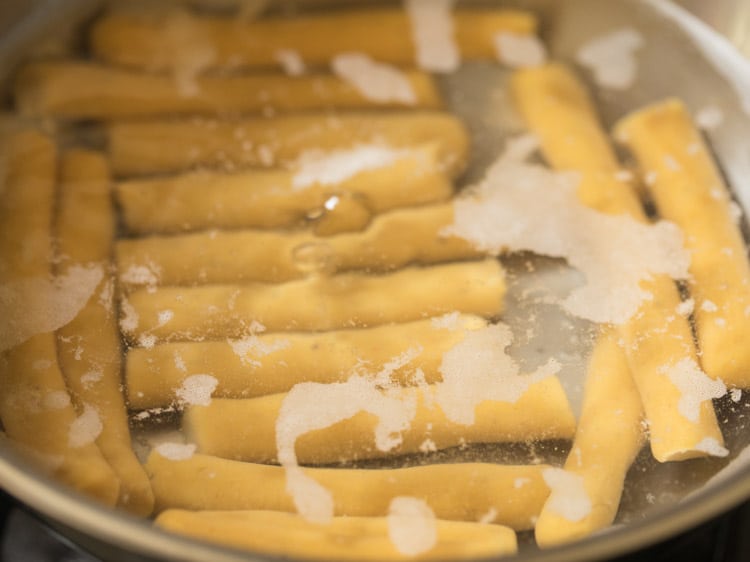
15. Once cooked, the gatte pieces will float on top and bubbles will be seen on them.
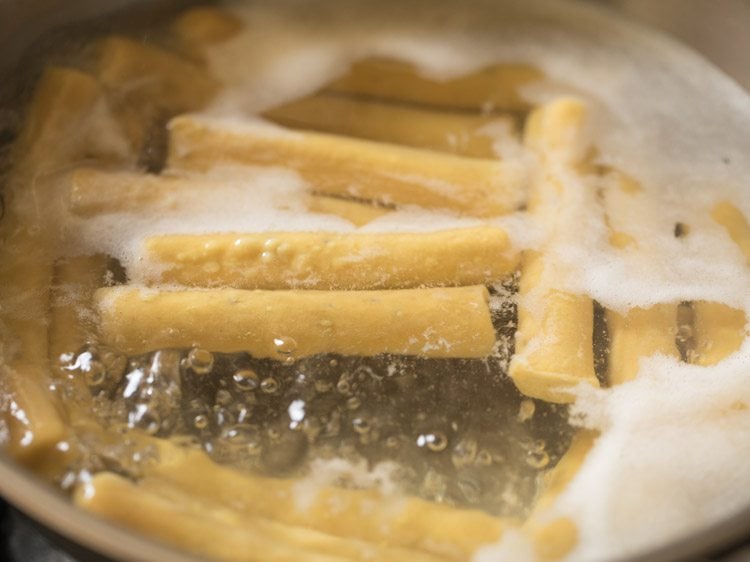
16. Gently remove them with a slotted spoon, draining the extra water.
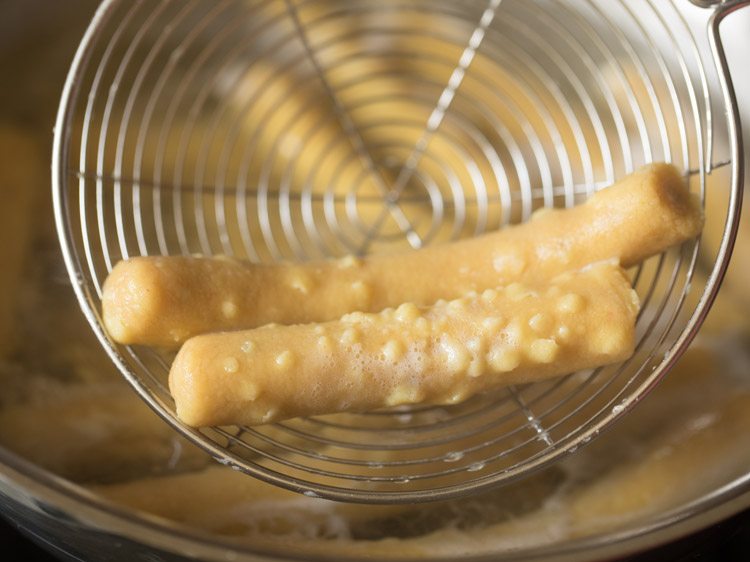
17. Place them on a board or plate and let them warm or cool to room temperature.
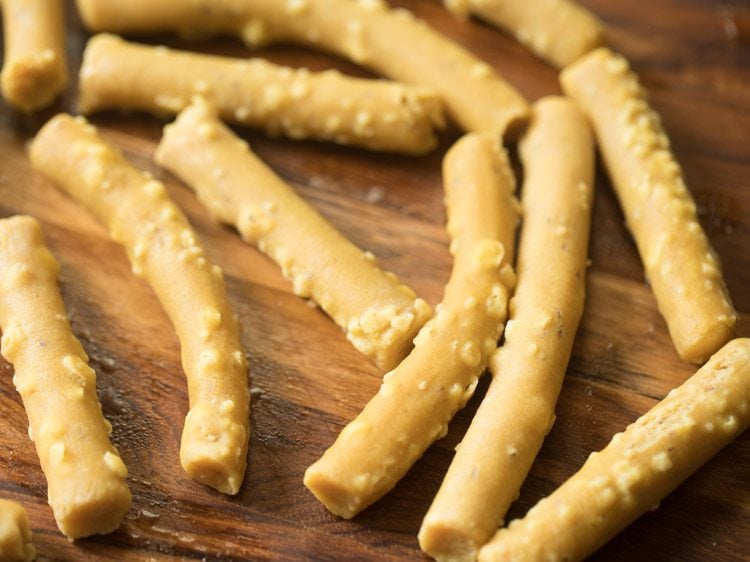
Making onion paste
18. In a small grinder or blender jar, take ½ cup roughly chopped onions, ½ teaspoon chopped garlic and ½ teaspoon chopped ginger.
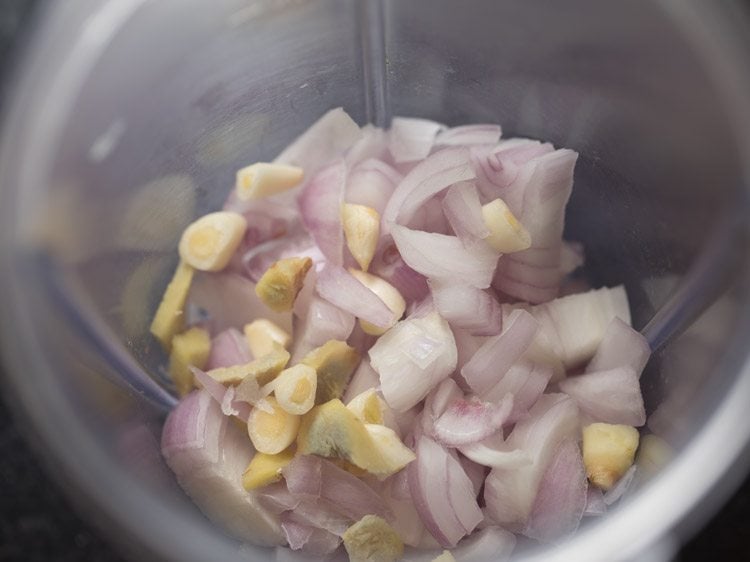
19. Add 1 to 2 tablespoons water or as required and blend to a fine paste. Keep aside.
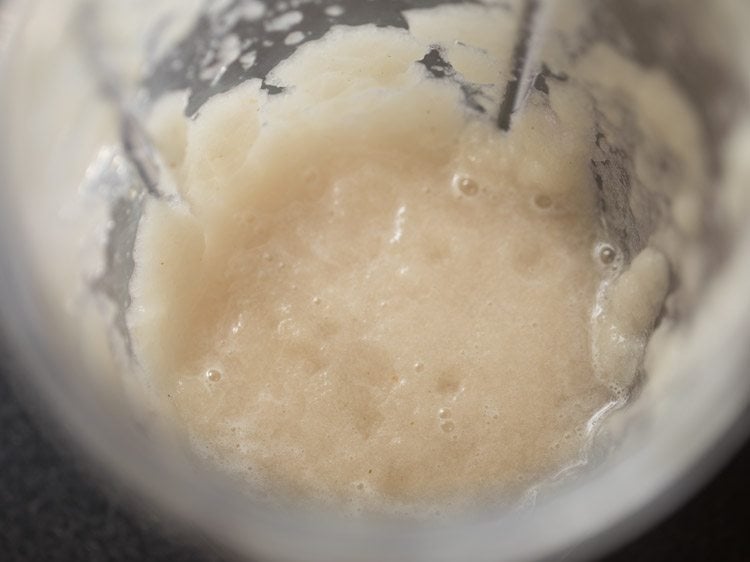
Making gravy
20. Whisk 1 cup (240 to 250 grams) curd till smooth. Keep aside.
Use full fat curd to make the sabji. Curd made from toned milk or skimmed milk will split. Best is to use homemade curd.
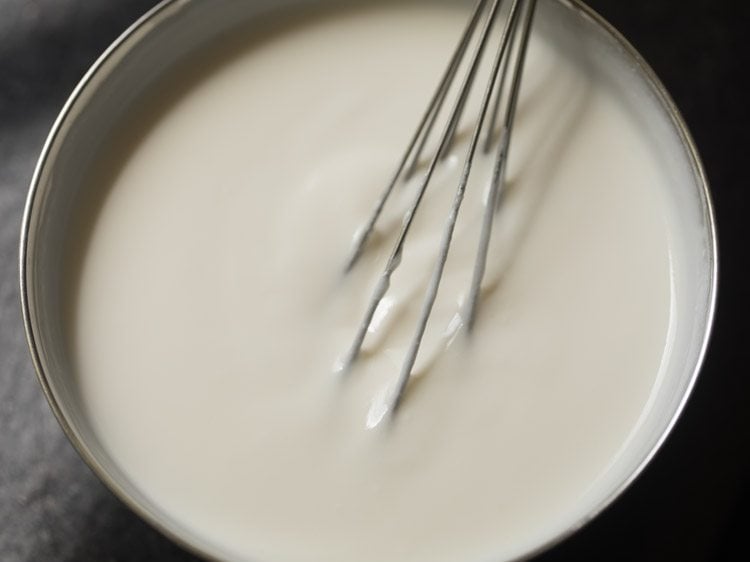
21. Reserve 1 cup of the water in which the gatte were cooked. Keep aside.
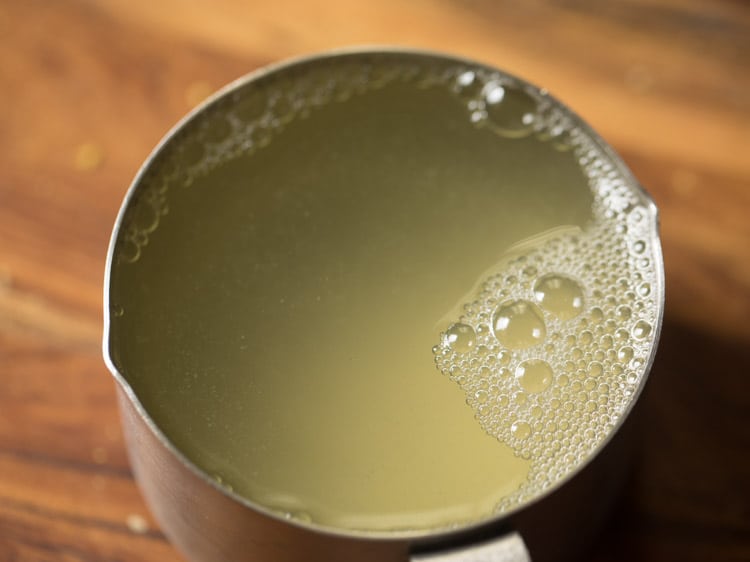
22. Cut the cooked gatte in small thick pieces.
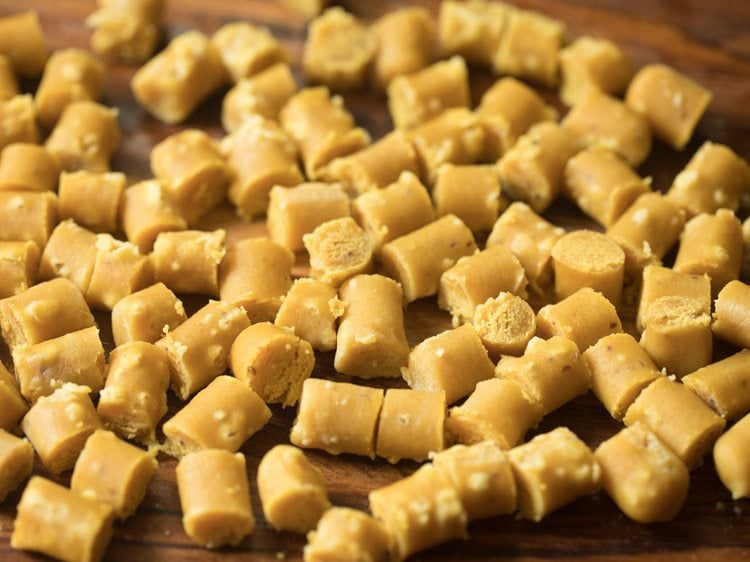
23. These gatte are soft and you can see the texture in this picture.
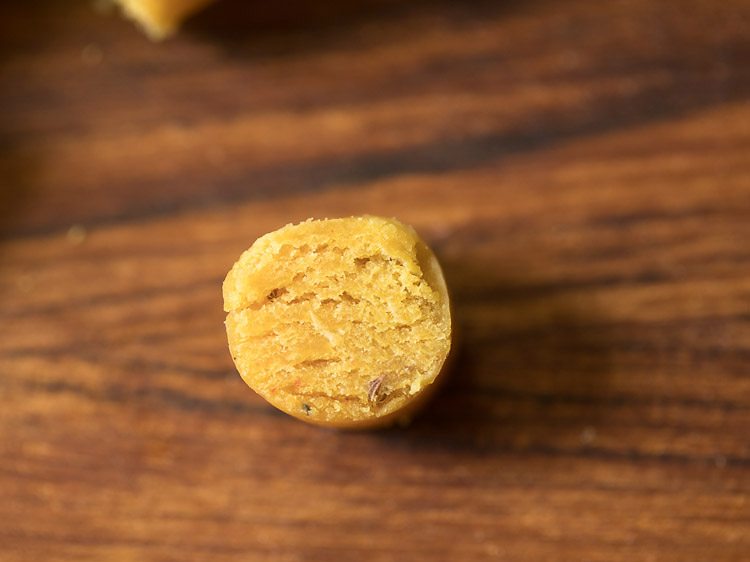
24. Heat 2 tablespoons oil or ghee in another pan. Keep the flame to a low or medium-low. Add 1 teaspoon cumin seeds, 3 cloves, 1 inch cinnamon, 2 green cardamoms, 1 small to medium bay leaf (tej patta) and 1 deseeded dried red chili. Fry the spices on low heat till they crackle. Do not burn the spices.
Add all the spices together. So, keep them ready before you heat the oil.
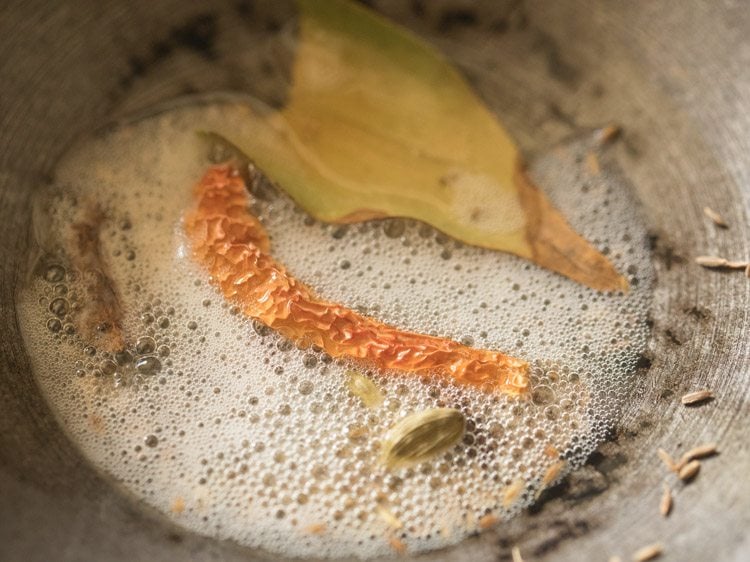
25. Now, add the prepared onion paste. Take care as the onion paste splutters when you add it.
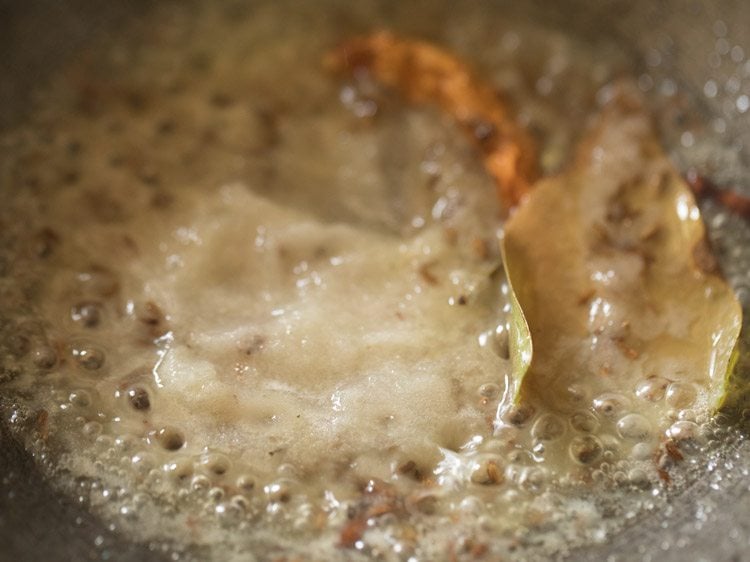
26. Mix well and begin to sauté on low to medium-low heat.
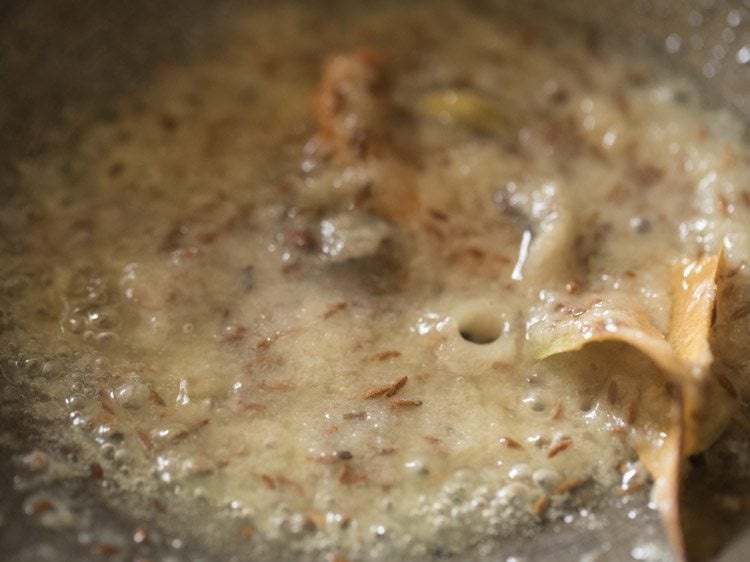
27. Sauté the onion paste, stirring often.
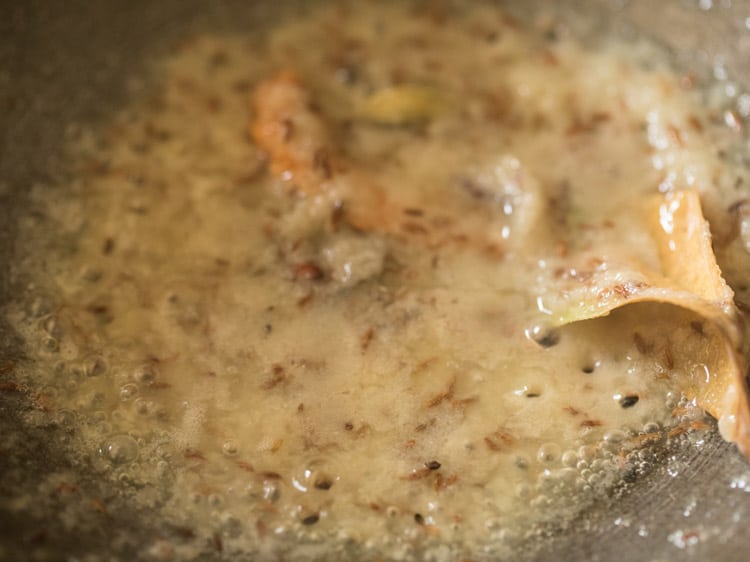
28. Sauté till the paste turns golden.
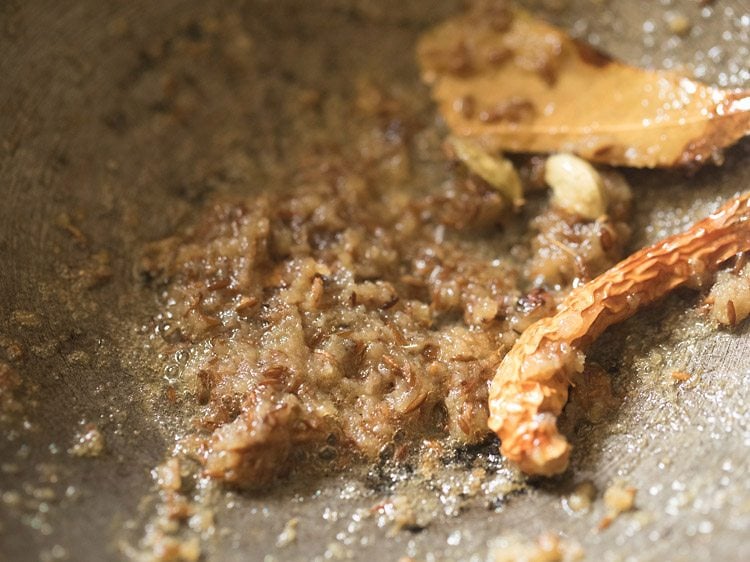
Making Gatte Ki Sabji
29. Switch off the heat and add the whisked curd. You can also add the curd in parts.
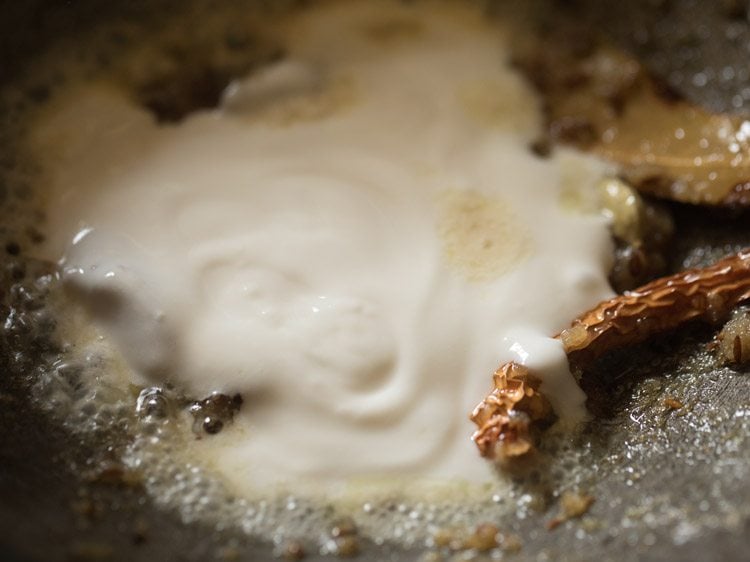
30. Quickly mix the curd very well with the sautéed onion paste.
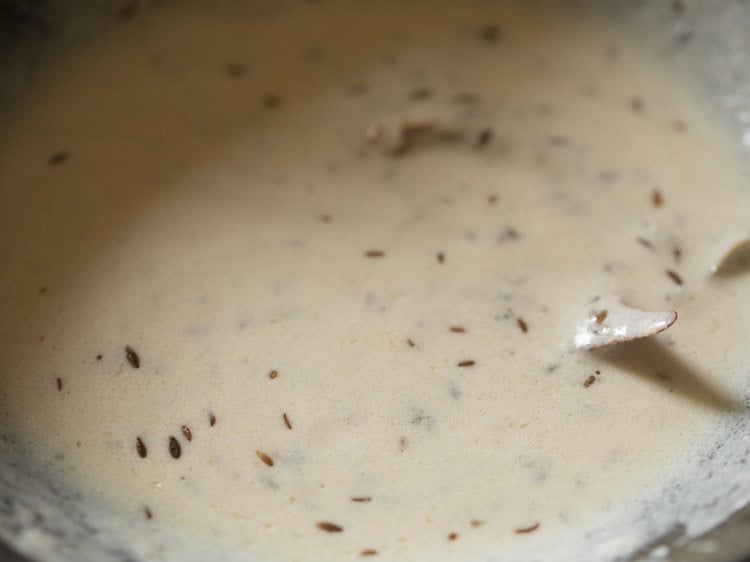
31. Now, switch on the heat keep stirring continuously while the curd gets cooked on low heat.
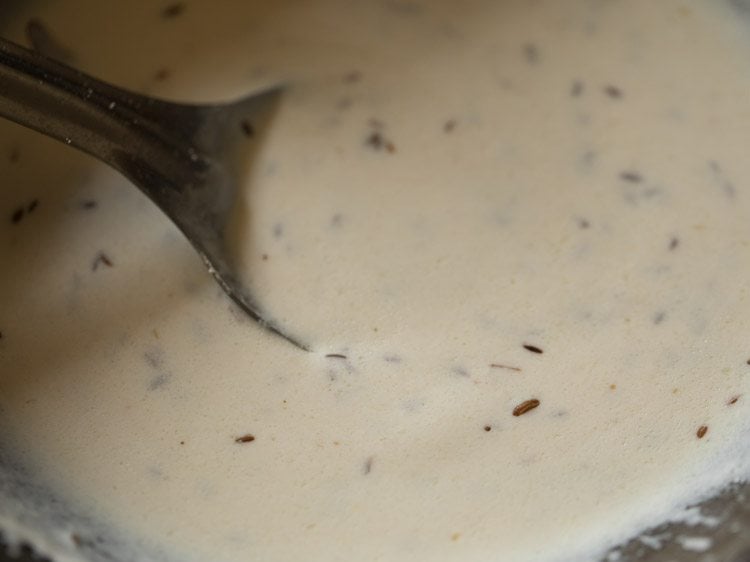
32. Let the curd come to a boil and you will see some oil specks on top. Stir continuously.
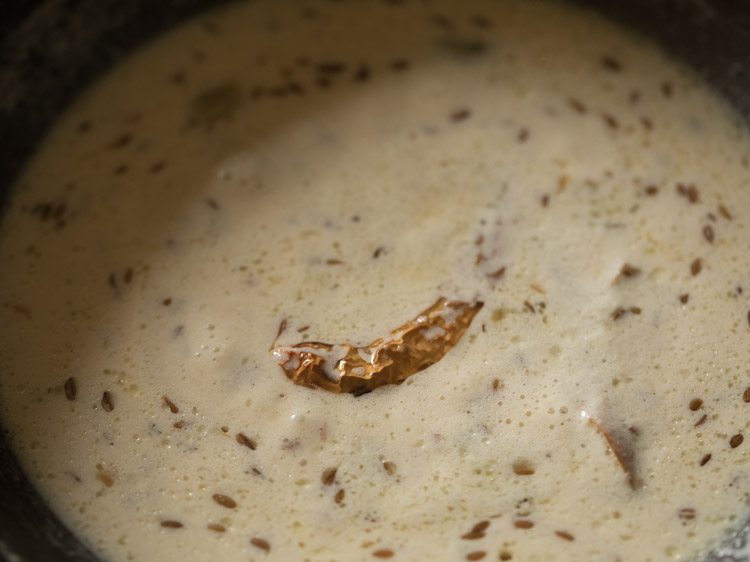
33. Next, add the spice powders one by one – ½ teaspoon turmeric powder, 2 teaspoons red chili powder, 1 tablespoon coriander powder and 1 pinch asafoetida (optional).
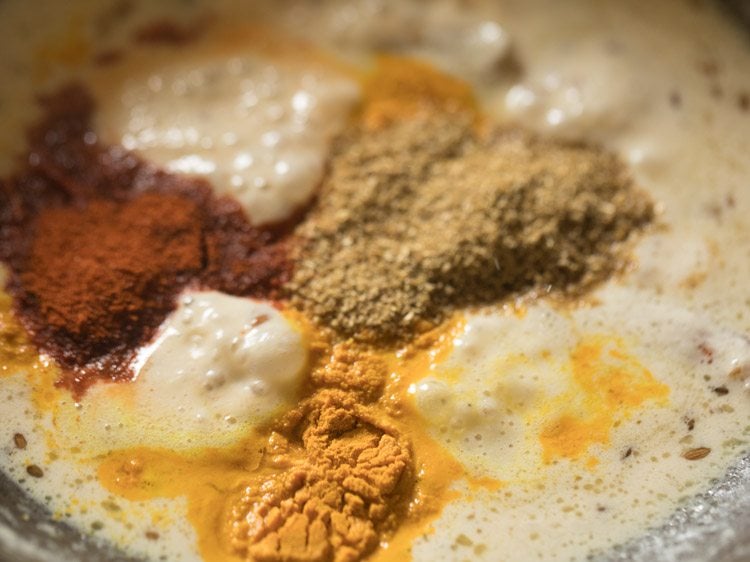
34. Mix the spice powders very well with the curd.
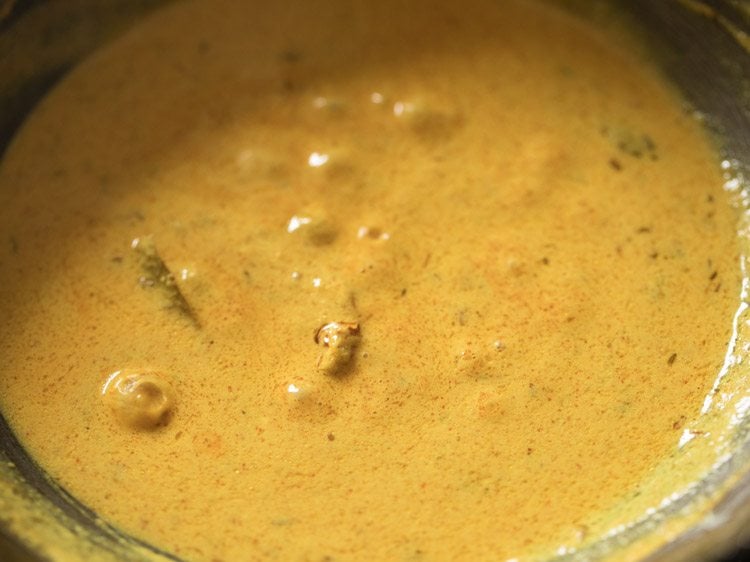
35. Continue to cook for 1 to 2 minutes or till you see some oil floating on top.
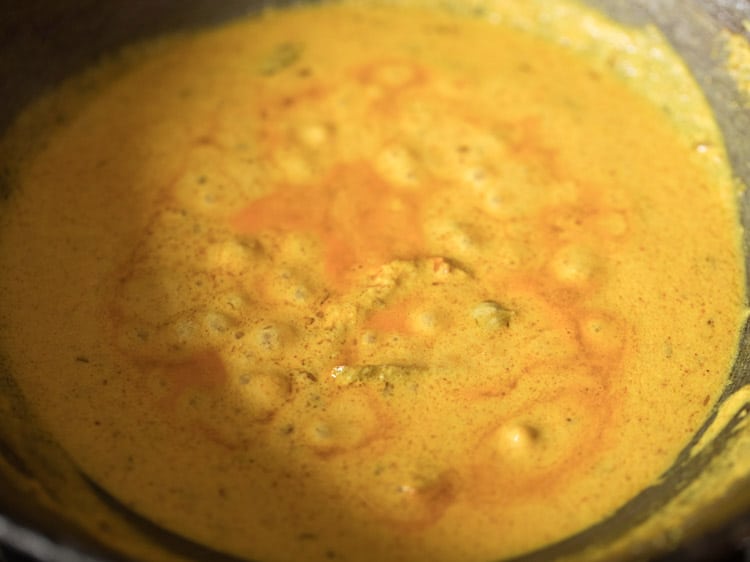
36. Now, add 1 cup of the reserved water in which the gatte were cooked.
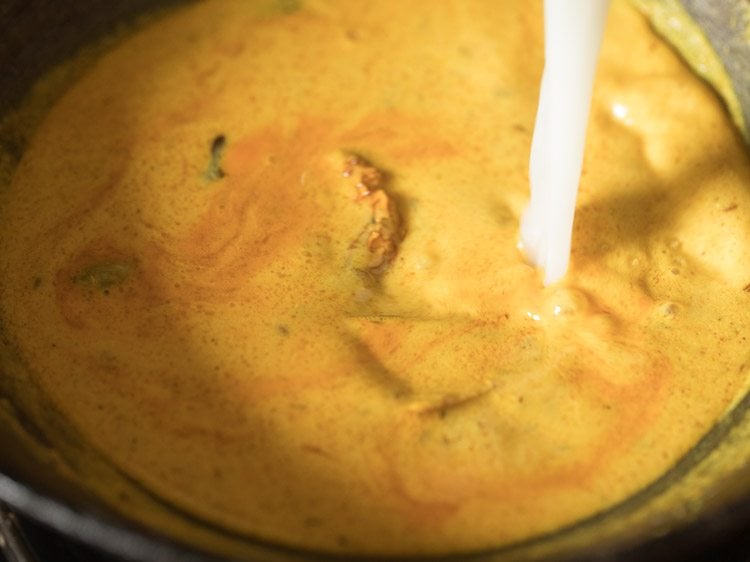
37. Mix very well.
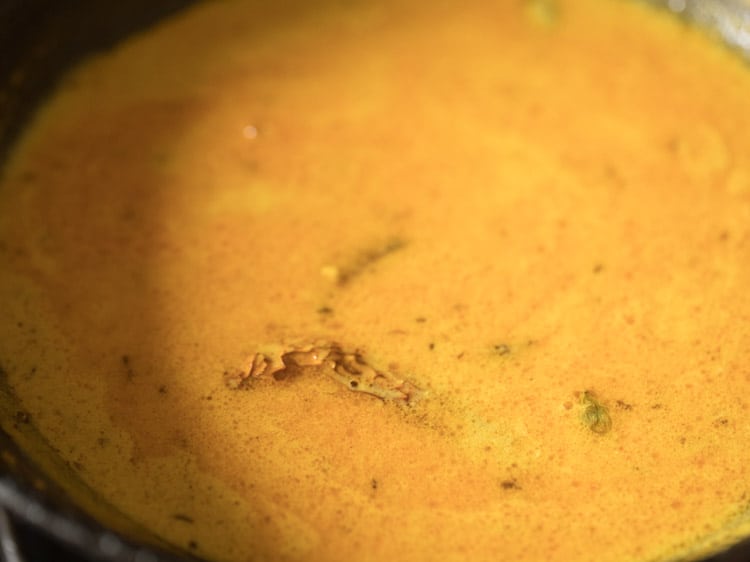
38. Add salt as per taste. Mix again.
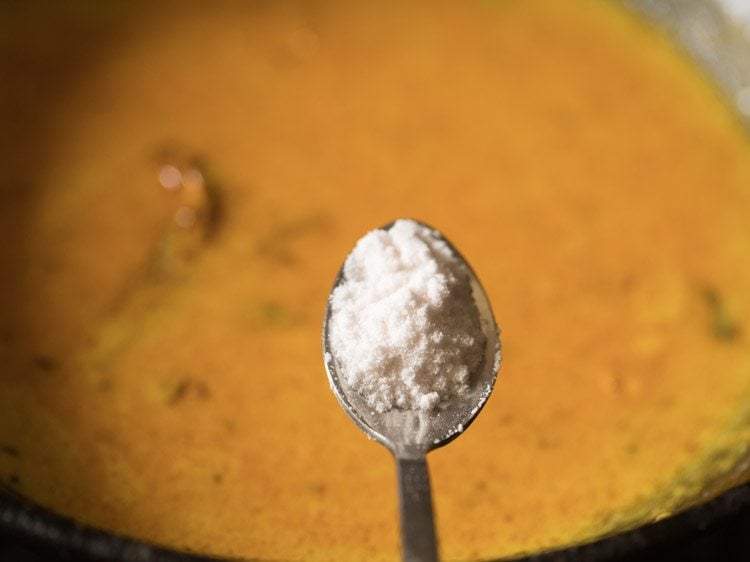
39. Simmer the gravy on medium-low heat. Stir at intervals.
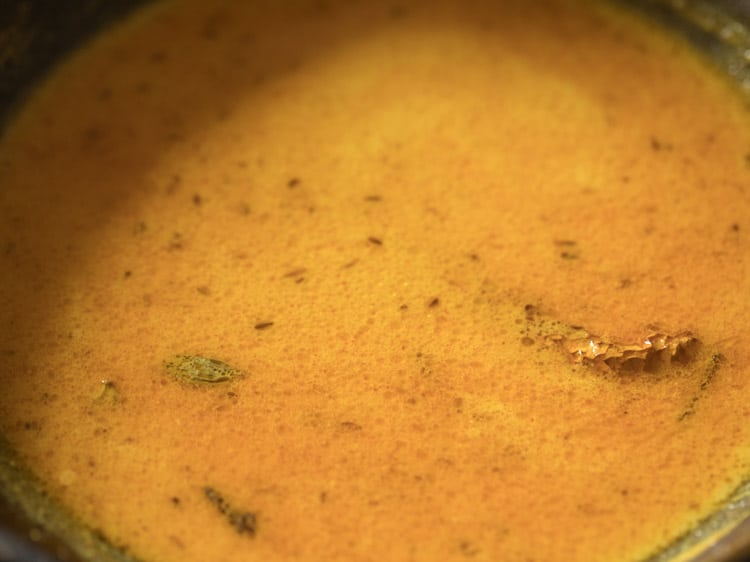
40. Let the gravy come to a boil.
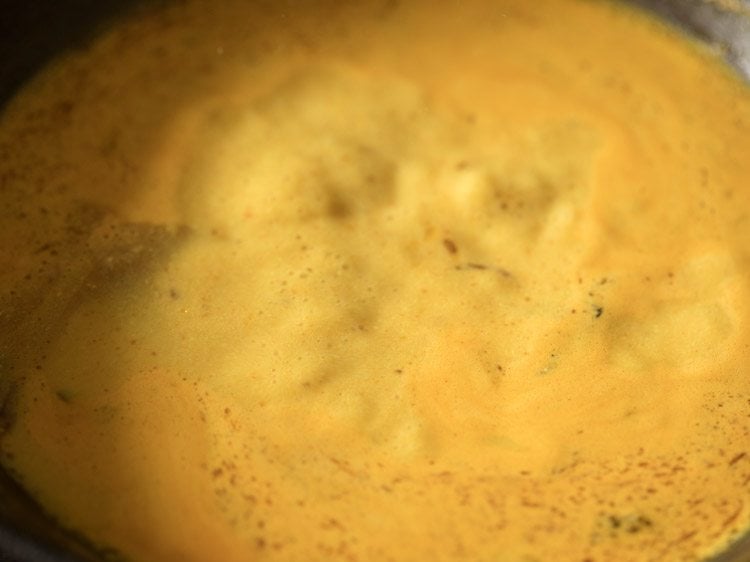
41. Once the gravy comes to a boil, add the cooked gatte pieces.
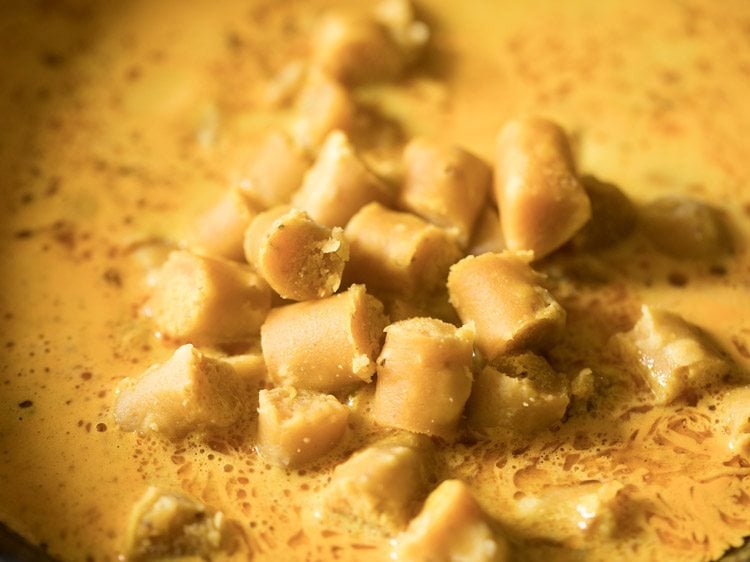
42. Stir gently and lightly.
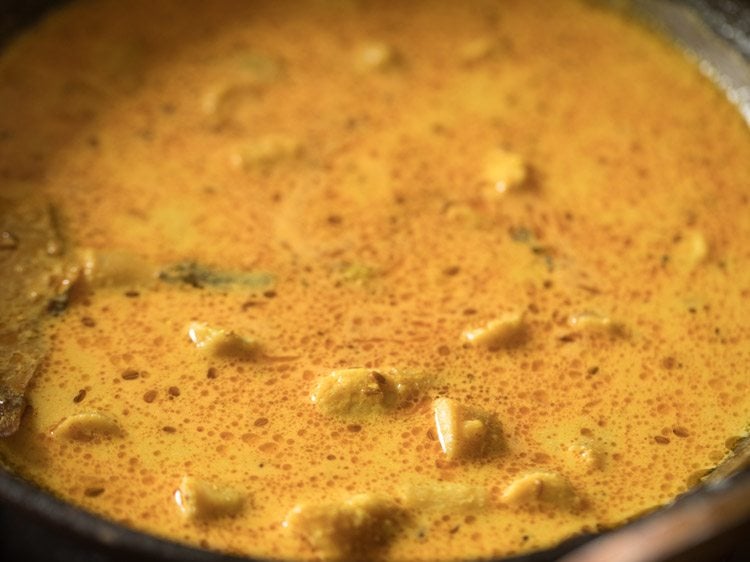
43. Simmer on low to medium-low heat for about 5 to 6 minutes or till the gravy thickens slightly. Note that on cooling, the gravy will thicken more.
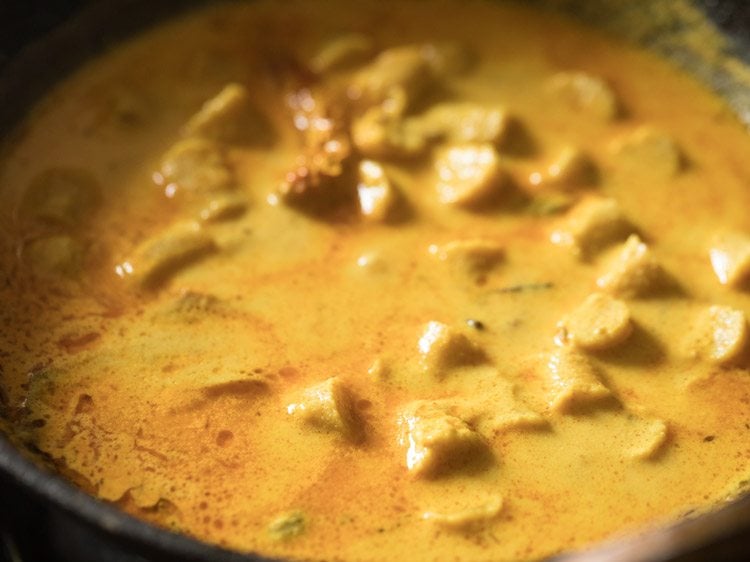
44. Later, switch off the heat and add 2 tablespoons chopped coriander leaves.
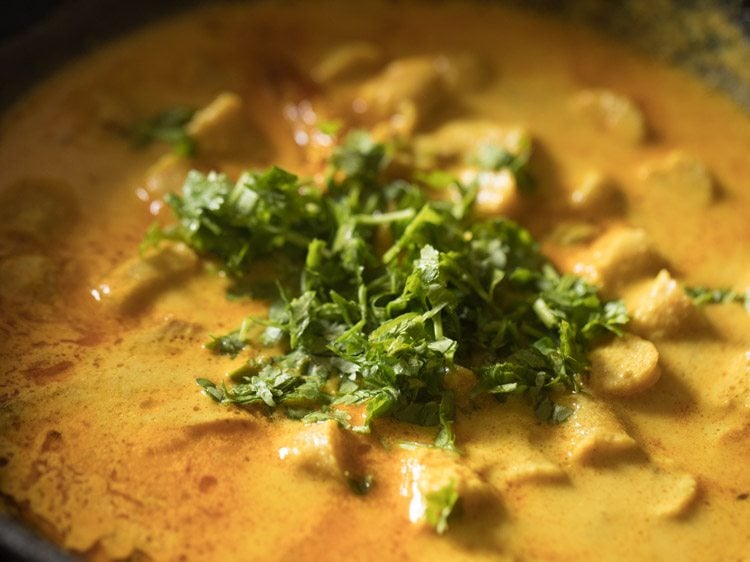
45. Serve Gatte Ki Sabji with steamed rice, Jeera Rice, chapatti, phulka, Paratha, jowar roti or bajra roti.
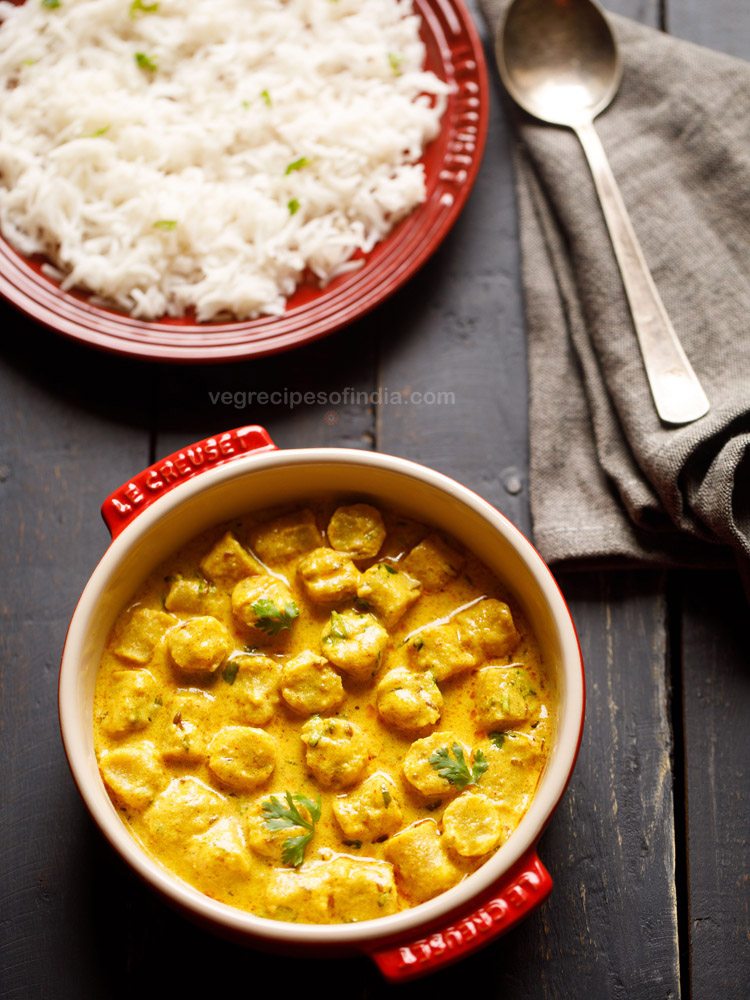
Expert Tips
- Using full-fat curd, especially homemade, is the best thing for this recipe. Do not use curd made from low fat milk or toned milk, as these can split of curdle easily while getting cooked.
- You can easily make this recipe without adding onion and garlic in it.
- For a spicier gatta sabzi, you can add 2 teaspoons red chili powder. For a less spicy sabzi, you can add about ½ to 1 teaspoon red chili powder and also ½ tablespoons coriander powder.
- For the gravy, adding asafoetida (hing) is also optional. You can skip it.
- While kneading the dough for gatte, add water depending on the type of the flour. Also, if you are using curd with more whey in it or is watery, use less of it.
- The dough has to be kneaded to a semi-soft consistency, like that of a poori dough. There should be no cracks on it. In case there are, then sprinkle some water and continue to knead. If it is sticky, add some gram flour and knead.
- You can make gatte a day prior. Add to the gravy, the next day. Keep the gatte in refrigerator, if making a day prior.
- Water has to be added as per your requirements. According to the consistency that you prefer.
More Curd Recipes To Try!
Potato Recipes
Gluten Free Recipes
Punjabi Food
Snacks Recipes
Please be sure to rate the recipe in the recipe card or leave a comment below if you have made it. For more vegetarian inspirations, Sign Up for my emails or follow me on Instagram, Youtube, Facebook, Pinterest or Twitter.
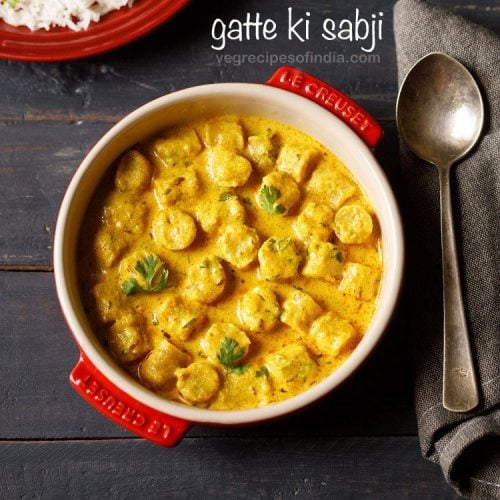
Gatte ki Sabji
Ingredients
for making gatte
- 2 cups besan or 200 grams
- 1 pinch asafoetida (hing)
- ¼ teaspoon turmeric powder
- ½ teaspoon carom seeds (ajwain)
- ½ teaspoon red chili powder
- 1 teaspoon Coriander Powder
(ground coriander)
- 1 teaspoon salt or add as required
- 3 tablespoons oil
- 2 tablespoons Curd or 30 grams (yogurt)
- 4 to 5 tablespoons water or add as required for kneading
- 4 cups water for cooking gatte
for onion paste
- ½ cup roughly chopped onion or 1 medium sized onion
- 3 to 4 small to medium garlic cloves or ½ teaspoon chopped garlic
- ½ inch ginger or ½ teaspoon chopped ginger
- 1 to 2 tablespoons water or add as required – optional for grinding
for making gatte ki sabji (gravy)
- 2 tablespoons oil or ghee
- 1 teaspoon cumin seeds
- 3 cloves
- 1 inch cinnamon
- 2 green cardamoms
- 1 small to medium tej patta
- 1 dry red chilli – seeds removed
- 1 cup Curd or 240 to 250 grams, beaten
- 1 pinch asafoetida (hing)
- ½ teaspoon turmeric powder
- 2 teaspoons red chilli powder
- 1 tablespoon Coriander Powder
- 1 cup of the cooked gatte water or add as required
- salt as required
- 2 tablespoons chopped coriander leaves
(cilantro leaves)
Instructions
making dough for gatte
- In a large bowl or a plate, take 2 cups besan (200 grams).
- Add the following ingredients – 1 pinch asafoetida, ¼ teaspoon turmeric powder, ½ teaspoon carom seeds (ajwain), ½ teaspoon red chili powder and 1 teaspoon coriander powder. Also add 1 teaspoon salt or add as per taste.
- Add 3 tablespoons oil and 2 tablespoons curd. mix everything very well. making sure that the oil is mixed evenly.
- Then add water in parts and begin to knead. Knead very well allowing the besan to absorb water. Overall knead for 10 to 11 minutes.
- You will need 4 to 5 tablespoons water. Addition of water will depend on the type of flour. Also if the curd used is watery or has more whey in it, less water will be required.
- Knead to a semi soft dough like a poori dough. It should be easy to roll and shape without applying too much of force or strength. You should not see cracks on the dough. If there are cracks, then sprinkle water and continue to knead. In case the dough becomes sticky, then sprinkle some besan and knead again.
cooking gatte
- Before making the gatte, take 4 cups water in a pan or kadai. Heat the water on medium or medium-high flame.
- Divide the besan dough in 6 equal parts. Roll each part to a smooth ball.
- Now with your fingers, roll each dough ball to a soup stick like cylindrical shape.
- Do this with all the 6 dough pieces. Slice each dough piece in two to three parts so that they can be placed easily in the kadai.
- Increase the flame to a high or medium-high and let the water come to a boil.
- Now gently place each gatte in the hot boiling water. Do not over crowd the pan. So its better to use a medium to large kadai.
- After they are cooked, the gatte pieces should float on top and bubbles will be seen on them. This means that they are cooked.
- Gently remove them with a slotted spoon draining the extra water.
- Place them on a board or plate and let them become warm or cool at room temperature.
making onion paste
- In a small grinder or blender jar, take ½ cup roughly chopped onion. Also add ½ teaspoon chopped garlic and ½ teaspoon chopped ginger.
- Add 1 to 2 tablespoons water or add as required and grind to a fine paste. Keep aside.
making gravy for gatte ki sabji
- Meanwhile whisk 1 cup of curd (240 to 250 grams) till smooth. Keep aside.
- Reserve 1 cup of the water in which the gatte were cooked. Keep aside.
- Cut the cooked gatte in small round thick discs.
- Heat 2 tablespoons oil or ghee in another pan. Keep flame to a low or medium-low.
- Add 1 teaspoon cumin seeds, 3 cloves, 1 inch cinnamon, 2 green cardamoms, 1 small to medium tej patta and 1 dry red chilli (seeds removed). Add all the spices together. So keep them ready before you heat the oil.
- Fry till all the spices crackle. Do not burn the spices, so fry them on a low flame.
- Now add the onion paste. Take care as the onion paste splutters when you add it.
- Mix well. Stirring often sauté onion paste on a low to medium-low flame till it turns golden.
making gatte ki sabzji
- Now switch off the flame and add the whisked curd. You can also add the beaten curd in parts.
- Quickly mix the curd very well with the sautéed onion paste.
- Now heat the pan on a low flame and keep on stirring continuously while the curd gets cooked.
- Let the curd come to a boil and you will see some oil specks on top.
- Then add all the spice powders one by one – ½ teaspoon turmeric powder, 2 teaspoons red chilli powder, 1 tablespoon coriander powder and 1 pinch asafoetida (optional).
- Mix the spice powders very well with the curd.
- Continue to sauté for 1 to 2 minutes till you see some oil floating on top.
- Now add 1 cup of reserved water in which the gatte were cooked. mix very well.
- Add salt as per taste. Mix again.
- Simmer the gravy or curry on a medium-low flame. Stir at intervals. let this gravy to a boil.
- Once the gravy comes to a boil, then add all of the gatte pieces. stir gently and lightly.
- Simmer on low to medium-low flame till curry thickens slightly. Overall cook the gatte ki sabji for about 5 to 6 minutes or till the gravy thickens slightly. Do note that on cooling the gravy thickens more.
- Later switch off the flame and add 2 tablespoons chopped coriander leaves.
- Serve gatte ki sabji with roti or parathas or jowar roti or bajra roti. You can also serve it with steamed rice or jeera rice.
Nutrition Info (Approximate Values)
This Gatte Ki Sabji Recipe from the archives was first published in March 2018. It has been updated and republished in April 2024.
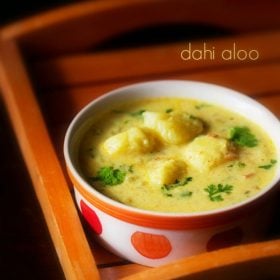
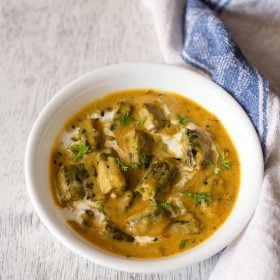
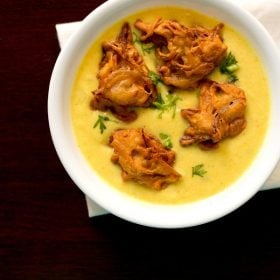
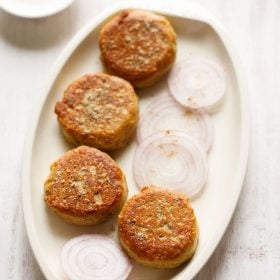
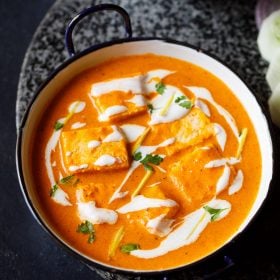
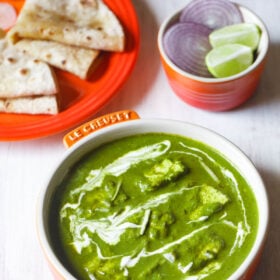
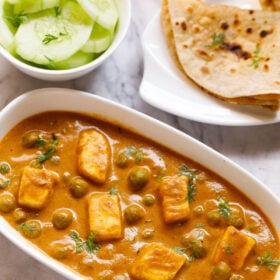
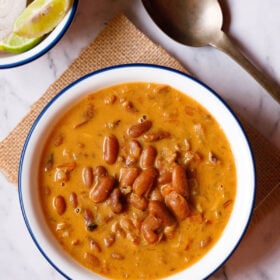








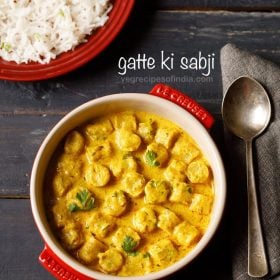
Superb.
Thanks.
Nice recipe!Can we keep it refrigerator for couple days?
since curd is added, i would suggest you to keep only for a day in the fridge.
I prepare on Friday , for the party at our house on Saturday. It turned out amazing and it was good for couple days. Thanks for the recipe and quick response.
welcome margi. thanks for sharing the review and feedback on the gatte ki sabji recipe. glad to know the recipe was amazing and stayed good for a couple of days.
Hi,
Can you give the recipe for the Punjabi gatte ki sabzi without curd?
hi jaya, i do not have correct recipe measurements now, but a rough one which i follow. one medium-sized onion, two medium to large tomatoes, 1 teaspoon ginger-garlic paste and spice powders are required. either you can finely chop onions or make a paste. for tomatoes also, you can make a puree or finely chop them. heat oil, add cumin seeds and 1 tej patta. let cumin seeds splutter, add a pinch of hing, followed by finely chopped onions. then saute till onions are translucent or light golden. for onion paste, saute till light golden. add ginger-garlic paste and saute till raw aroma goes away. add tomatoes or tomato puree. saute till oil leaves the sides of the masala.
then add turmeric, red chilli powder, coriander powder, tomatoes or onion-tomato paste. add salt and water as required. let the curry come to a boil. then add the gatta pieces and simmer for 4 to 5 minutes more. the gravy will thicken by this time. do not add more water. add water enough for the curry to have a medium consistency so that by the time the gate pieces are cooked, the gravy will thicken. lastly, add garam masala powder and crushed kasuri methi. add some chopped coriander leaves.
hope this helps.